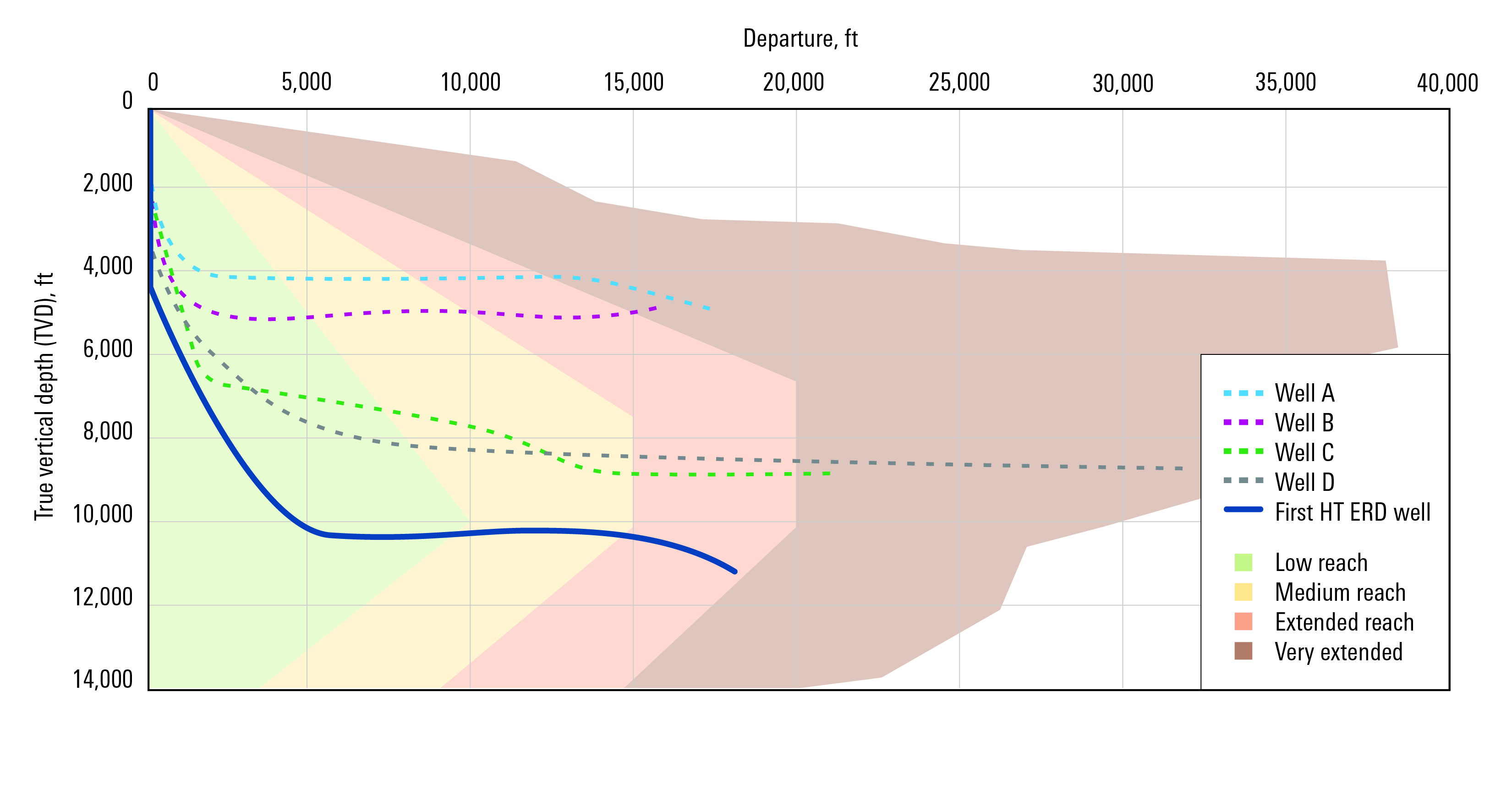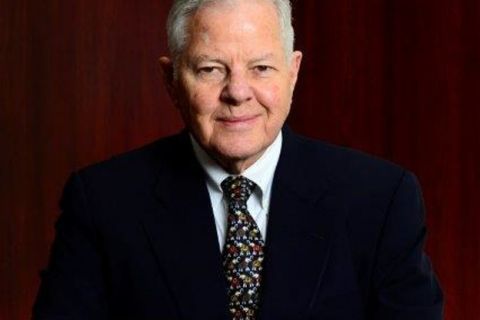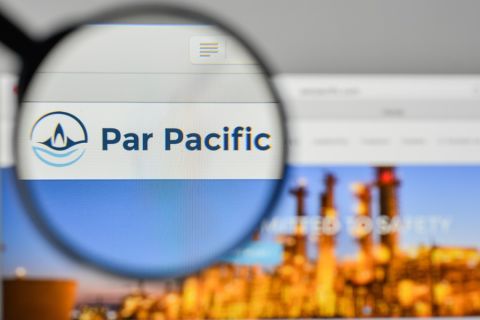Today’s wells are longer, deeper and hotter than ever before. As oil and gas recovery becomes increasingly complex, operators must implement innovative drilling technologies and new methodologies to optimize well economics. Successful well construction requires deep domain knowledge, technological sophistication and efficient operational execution.
Going beyond individual technological advancements, the next step in improving drilling performance involves integrating the entire drilling system—the bottomhole assembly (BHA), drilling fluid, drillstring and surface equipment—with a data-driven drilling workflow and technical expertise to address the specific challenges and complexities of each well.
Pushing the envelope
Extended-reach drilling (ERD) enables operators to develop assets more efficiently by maximizing reservoir exposure to a single wellbore and to access reservoirs that are located away from operation facilities. However, ERD wells present high operational risks, uncertainties and engineering challenges. When drilling these wells, operators typically face extreme hole-cleaning challenges and the inherent difficulty of transferring weight on bit.
In one project a Middle East operator planned to drill a deep ERD well through a high-temperature formation from a surface location adjacent to an urban area. Considered one of the most complex carbonate reservoirs in the Middle East because of its heterogeneous nature, the formation was made up of limestone, dolomite, anhydrite and small amounts of shale. In addition to penetrating formations with temperatures as high as 157 C (315 F), further ERD drilling challenges specific to this reservoir included bit balling, high torque and drag, wellbore instability, water flow, abrasive formations, overpressured formations, fluid losses and hydrogen sulfide.
Taking an integrated multidisciplinary approach
The operator worked with Schlumberger to integrate all elements of the well design. The project began with a geomechanics study and an in-depth offset well analysis to gain a detailed understanding of the ERD section to prevent wellbore damage. The study identified the safe mud-weight window by establishing that at 90 degrees the porous layers had a narrow mud weight while the tight layers had a wider mud weight. This helped to define that the ERD interval needed to be drilled in a low-porosity zone.
Based on the studies, specialized oil-based drilling fluids were selected for the ERD sections, and the drilling loads and conditions were analyzed using torque and drag, hydraulics, and temperature models. A temperature model was calibrated at a thermal factor of 1.4 with a confirmed reach of between 154 C (310 F) and 157 C. The model was matched with actual data, helping to anticipate the expected downhole dynamic temperature before the commencement of drilling during the ERD phase—essential for equipment setup and ensuring that the technologies were configured for such high temperatures.
Next, petrotechnical experts conducted a multidiscipline risk register. All potential hazards were identified by geological formation, and prevention and mitigation measures were proposed. Major hazards and mitigation actions were focused on wellbore stability, hole cleaning, torque and drag management, high mud solids, and abrasive and high-temperature drilling. The prejob planning and risk register resulted in the design of application-specific drilling systems and solutions that integrated drillbit design, directional drilling, LWD, drilling fluids, surface logging services and hole-cleaning services.
Drilling system selection, performance modeling
The planning phase was complemented with the implementation of ERD practices and high-temperature management. Using the IDEAS integrated drillbit design platform and the i-DRILL engineered drilling system design, different stabilization options were compared to identify optimal drilling parameters that would increase ROP and minimize vibration to mitigate BHA damage and failure. This was accomplished by combining a bit-rock cutting model based on laboratory testing with a finite element analysis of the bit and drillstring (Figure 1).

To deliver high ROP in the ERD interval of the well, the drilling team selected the PowerDrive rotary steerable systems (RSS). With full rotational capability, the RSS eliminated dragging components, enabling faster drilling to target depth and quicker pulling out of the hole due to the good hole condition, reducing time to production.
The operator used the RSS in the ERD section to ensure a high ROP. The RSS conditioned the hole while drilling, reducing the risk of sticking, casing wear and drillstring fatigue. The RSS was paired with the Sting- Blade conical diamond element bit for improved footage and ROP. The drive system delivered a 26% improvement compared with the operator’s previous extended-reach wells. The result was the first ERD section ever drilled in this heterogeneous carbonate formation.
In the reservoir interval, where temperatures were expected to reach more than 149 C (300 F) and the abrasive reservoir was to be penetrated, the PowerDrive Orbit RSS was selected for heat and abrasion resistance. The RSS was configured with highly abrasion- resistant deflection pads that proved to withstand a highly competent abrasive formation of 35,000-plus psi unconfined strength (Figure 2).

Although the well profile was designed to avoid possible H2S-bearing zones, a brine-soluble H2S scavenger was applied in the drilling fluid as a safeguard. In addition, the drilling team used a drilling fluid simulation software to simulate hole cleaning and manage equivalent circulating density on a daily basis.
Surface logging services also were selected, including a hole-cleaning and wellbore risk-reduction service to evaluate hole condition and cuttings recovery in the highly deviated sections of the well, a pore pressure analysis service, and a fluid loss and gain detection service. The OptiWell well construction performance service was deployed to integrate all wellsite data and provide recommendations to maximize ROP and minimize nonproductive time and reduce risks (Figure 3).

Setting new high-temperature well record
The operator drilled the high-temperature ERD well to a total depth of 7,658 m (25,125 ft) with no HSE incidents or downhole equipment failures within the planned time frame. In addition to being the first high-temperature ERD gas well drilled by the operator, the well set a record for the operator’s deepest ERD well.
Pre-job planning and a detailed risk assessment not only delivered an integrated drilling system but also provided a holistic approach by considering the wireline logging and cementing operations. The well design and robust hole condition made it possible to run and cement the 7-in. ERD liner smoothly and to deliver the deepest tough logging conditioning system wireline run in the Middle East. By combining technologies and technical expertise, the operator was able to push the boundaries of directional drilling, setting the benchmark for future high-temperature ERD wells in terms of well construction efficiency, safety and execution.
Recommended Reading
73-year Wildcatter Herbert Hunt, 95, Passes Away
2024-04-12 - Industry leader Herbert Hunt was instrumental in dual-lateral development, opening the North Sea to oil and gas development and discovering Libya’s Sarir Field.
Green Swan Seeks US Financing for Global Decarbonization Projects
2024-02-21 - Green Swan, an investment platform seeking to provide capital to countries signed on to the Paris Agreement, is courting U.S. investors to fund decarbonization projects in countries including Iran and Venezuela, its executives told Hart Energy.
Marathon Petroleum Sets 2024 Capex at $1.25 Billion
2024-01-30 - Marathon Petroleum Corp. eyes standalone capex at $1.25 billion in 2024, down 10% compared to $1.4 billion in 2023 as it focuses on cost reduction and margin enhancement projects.
Par Pacific Asset-based Revolving Credit Bumped Up by 55%
2024-03-25 - The amendment increases Par Pacific Holdings’ existing asset-based revolving credit facility to $1.4 billion from $900 million.
Prairie Acquiror Announces Offering of $400MM Senior Notes
2024-02-21 - Prairie Acquiror intends to use the notes offering to refinance outstanding debt under its existing term loan credit facility.





